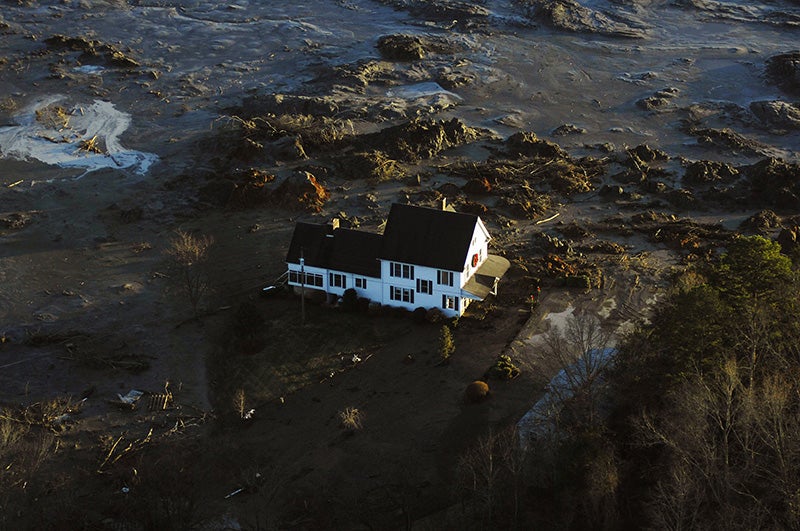First-ever Coal Ash Rule Published: Safeguards Begin This Fall
Victory
—EPA safeguard brings relief, but communities concerned about House efforts to stop these overdue protections
Contact
The U.S. Environmental Protection Agency (EPA) today published its final coal ash rule that sets an effective date for public health safeguards as early as October 17, 2015. The long-awaited federal rule was signed on December 19, 2014, but its publication was delayed for several months.
While communities across the U.S. wait for the safeguards to take effect, there is fear that efforts by some in the U.S. House of Representatives will derail this EPA protection before it is even implemented. Rep. David McKinley (R-WV) has proposed H.R. 1734, a bill that guts the new rule by eliminating, weakening or delaying important public health safeguards. The House is expected to vote on the bill later this month.
“Our communities need relief from this toxic-laden and grossly mismanaged waste. From Chester, West Virginia to Salinas, Puerto Rico, impacted and concerned citizens and state legislators are urging Congress to oppose Rep. McKinley’s ‘Improving Coal Combustion Residuals Regulation Act of 2015,’” said Andrea Delgado, Legislative Representative at Earthjustice. “Given the finalization of the rule and the non-hazardous designation for this waste, H.R. 1734 is a gratuitous attack to minimum protections that communities have been demanding for years.”
The Obama Administration’s first-ever coal ash regulations are intended to prevent future environmental disasters like the Dan River coal ash spill in North Carolina and the massive 2008 spill in Kingston, Tennessee and stop additional cases of contamination of water and air caused by coal ash. The EPA first proposed a coal ash rule in 2010, following the largest toxic waste spill in U.S. history at a TVA plant in Kingston, when one billion gallons of coal ash sludge destroyed 300 acres and dozens of homes. Three major coal ash spills have occurred since 2008, and coal ash has contaminated water at more than 200 sites in 37 states.
The final rule establishes minimum disposal standards that apply to more than 1,000 coal ash dumps throughout the U.S. The rule includes safeguards addressing toxic dust, structural stability of dams impounding coal ash and design standards to prevent, detect and cleanup toxic leaks from coal ash dumps. The rule also encourages closure within three years of inactive coal ash ponds, like the Dan River pond that burst last February fouling 80 miles of river with toxic sludge. The EPA rule sets standards that are applicable to power plants and dumps in all 50 states.
“EPA’s rule finally brings some relief to hundreds of communities across the nation who have been harmed by the unregulated dumping of toxic coal ash,” said Earthjustice attorney Lisa Evans. “No longer can polluters escape basic health and safety requirements by operating in states that have none.”
The new EPA rule represents a compromise, which disappointed public interest groups but fulfilled the many demands of the electric utility industry, states and recyclers. Despite deep concessions to these interest groups, communities harmed by leaking dumps view the rule as a step forward.
“Abandoned ponds threaten our environment, health and economic security, “ said Emily Russell of VA Conservation Network. “We want these toxic basins safely closed in Virginia as quickly as possible before there is another disaster like the Dan River spill.”
The rule also puts in place safeguards for large “fill” projects, where dangerous volumes of coal ash are disposed in the guise of “beneficial” reuse. While the EPA rule exempts legitimate beneficial reuse of coal ash, it also requires those who use quantities of coal ash over 12,400 tons to document that such use will not be harmful to health or the environment.
“Coal ash has been used as fill all over Wisconsin, and many communities have drinking water contamination,” said Katie Nekola, General Counsel of Clean Wisconsin. “EPA’s final rule will help protect our water because it requires testing to ensure harmful chemicals will not reach drinking water sources.”
The EPA also requires contamination of water be reported and cleaned up, if coal ash releases occur.
“Coal ash ponds and landfills are a looming threat to the water resources we treasure in Minnesota. These waste dumps have already tainted our drinking water with dangerous pollutants like arsenic. The EPA rule helps ensure that coal ash does not continue to poison our wells,” said Jessica Dexter of the Environmental Law & Policy Center in Duluth, MN.
The new rule also prohibits the dumping of coal ash within five feet of an aquifer.
“It is essential to separate toxic coal ash landfills and ponds from water so that groundwater and nearby waterways are protected from the leaching of hazardous chemicals,” said Patricia Schuba, President of Labadie Environmental Organization in Labadie, MO.
Coal ash is the toxic waste formed from burning coal in power plants to make electricity. It is filled with some of the deadliest toxins known to man, including hazardous chemicals such as arsenic, lead, mercury and hexavalent chromium. Coal ash—the second largest industrial waste stream in the United States-—is linked to the four leading causes of death in the U.S.: heart disease, cancer, respiratory diseases and stroke.
“Regulation of coal ash is long overdue and critically important to the health of all Americans,” said Dr. Alan Lockwood, past president of Physicians for Social Responsibility. “We are relieved to see the rule finally published. The toxic chemicals in coal ash have no place in our air or water.”

Additional Resources
About Earthjustice
Earthjustice is the premier nonprofit environmental law organization. We wield the power of law and the strength of partnership to protect people's health, to preserve magnificent places and wildlife, to advance clean energy, and to combat climate change. We are here because the earth needs a good lawyer.